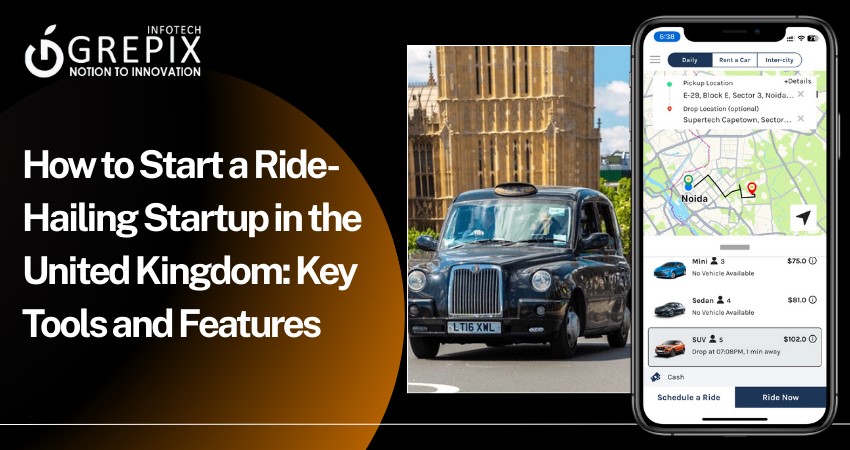How to Start a Ride-Hailing Startup in the United Kingdom: Key Tools and Features
Starting a ride-hailing startup in the United Kingdom involves navigating a complex landscape of regulations, technology choices, and market dynamics. This comprehensive guide provides aspiring entrepreneurs with essential insights into the UK taxi market, licensing requirements, market research, service modeling, vehicle acquisition, technology selection, marketing strategies, financial planning, risk management, and scaling opportunities. By understanding these key components, you can effectively launch and grow a successful taxi service in the United Kingdom
1Introduction: United Kingdom Taxi Market Overview
The United Kingdom's taxi and private hire vehicle (PHV) industry is a dynamic and integral part of the nation's transportation network. As of 2024, there are approximately 313,000 licensed taxi and PHV vehicles in England alone, marking an 8.2% increase from the previous year. This growth is primarily driven by a 10.5% rise in PHV numbers, highlighting the increasing demand for flexible and convenient transportation options.
The UK taxi market is characterized by a mix of traditional black cabs and modern ride-hailing services. London, for instance, maintains a distinct presence of iconic black cabs, while cities across the UK have seen a surge in app-based ride-hailing services like Uber, Bolt, and Free Now. The integration of technology has revolutionized the industry, offering real-time tracking, digital payments, and enhanced customer experiences.
However, the market is not without challenges. Traditional taxi operations have faced stiff competition from ridesharing services, leading to a decline in revenue for some operators. Despite these challenges, the market presents significant opportunities for new entrants who can offer innovative solutions and adapt to evolving consumer preferences.
Key Takeaways:
- The UK taxi market is growing, with a notable increase in PHV numbers.
- Technological integration is reshaping customer expectations and service delivery.
- Opportunities exist for startups that can navigate regulatory landscapes and offer differentiated services.
2Understanding the United Kingdom Regulatory Environment
Navigating the regulatory environment is crucial for establishing a compliant and successful ride-hailing startup in the UK. The licensing requirements vary across regions, with local authorities responsible for issuing licenses and enforcing regulations.
1. Driver Licensing Requirements:
- Age and Driving Experience: Applicants must be at least 18 years old and have held a full UK driving license for a minimum of 12 months.
- Right to Work: Proof of the legal right to live and work in the UK is mandatory.
- Background Checks: An enhanced criminal records check from the Disclosure and Barring Service (DBS) is required.
- Medical Fitness: A Group 2 medical examination assesses the applicant's fitness to drive.
- Knowledge Test: Some regions, like London, require drivers to pass a knowledge test covering local geography and regulations.
2. Vehicle Licensing Requirements:
- Vehicle Standards: Vehicles must meet specific standards regarding age, emissions, and safety features.
- MOT Certification: A valid MOT certificate is necessary, often issued within 10 days of the application.
- Insurance: Appropriate hire and reward insurance coverage is mandatory.
3. Operator Licensing:
- Business Premises: Operators must have a registered business address within the licensing authority's jurisdiction.
- Record Keeping: Maintaining detailed records of bookings and driver information is required.
- Compliance with Regulations: Operators must adhere to local bylaws and conditions set by the licensing authority.
4. Regional Variations:
- London: Transport for London (TfL) oversees licensing, with specific requirements like the Knowledge test for black cab drivers.
- Other Regions: Licensing requirements can vary, so it's essential to consult the local council's guidelines.
5. Key Takeaways:
- Compliance with licensing requirements is non-negotiable and varies by region.
- Thoroughly research local regulations and maintain open communication with licensing authorities.
- Ensure all drivers and vehicles meet the stipulated standards to avoid penalties and maintain service quality.
3Conducting In-Depth Market Research
Before launching your ride-hailing startup, conducting comprehensive market research is essential to understand the competitive landscape, customer preferences, and potential demand.
1. Market Analysis:
- Demographics: Analyze the population size, age distribution, and income levels in your target area to assess potential demand.
- Transportation Needs: Identify gaps in existing transportation services, such as underserved areas or specific customer segments.
- Competitor Analysis: Evaluate existing taxi services, ride-hailing apps, and public transportation options to identify opportunities for differentiation.
2. Customer Preferences:
- Service Expectations: Understand what customers value most—be it affordability, convenience, safety, or luxury.
- Technology Usage: Assess the prevalence of smartphone usage and comfort with app-based services among your target demographic.
3. Regulatory Environment:
- Licensing Landscape: Research the ease or complexity of obtaining necessary licenses in your chosen area.
- Policy Trends: Stay informed about potential regulatory changes that could impact your operations.
4. Data Collection Methods:
- Surveys and Interviews: Gather firsthand insights from potential customers and drivers.
- Focus Groups: Engage with small groups to delve deeper into customer expectations and preferences.
- Secondary Research: Utilize existing reports, government publications, and industry analyses to inform your strategy.
5. Key Takeaways:
- In-depth market research informs strategic decisions and helps identify unique value propositions.
- Understanding customer needs and preferences is crucial for service design and marketing.
- Stay abreast of regulatory developments to anticipate and adapt to changes.
4Defining Your Service Model and Target Audience
Establishing a clear service model and identifying your target audience are foundational steps in building a successful ride-hailing startup.
1. Service Models:
- Standard Ride-Hailing: Offer on-demand transportation services through a mobile app, catering to the general public.
- Luxury Services: Provide premium vehicles and professional drivers for customers seeking a high-end experience.
- Shared Rides: Implement carpooling options to offer cost-effective solutions and reduce environmental impact.
- Specialized Services: Cater to specific needs, such as wheelchair-accessible vehicles or services for senior citizens.
2. Target Audience Segmentation:
- Commuters: Focus on daily travelers seeking reliable and timely transportation.
- Tourists: Offer services tailored to visitors, including multilingual support and city tours.
- Corporate Clients: Provide business accounts with features like expense tracking and priority booking.
- Students: Develop affordable options for university students, possibly in partnership with educational institutions.
3. Value Proposition:
- Safety and Reliability: Emphasize driver vetting processes and vehicle maintenance standards.
- Convenience: Highlight features like easy booking, real-time tracking, and multiple payment options.
- Affordability: Offer competitive pricing and transparent fare structures.
4. Key Takeaways:
- Align your service model with the specific needs and preferences of your target audience.
- Differentiation through specialized services can create a competitive edge.
- A clear value proposition communicates the benefits of your service to potential customers.
5Vehicle Acquisition and Driver Recruitment
Securing a reliable fleet and recruiting qualified drivers are critical components of your ride-hailing startup.
1. Vehicle Acquisition Strategies:
- Ownership: Purchase vehicles to maintain full control over the fleet, ensuring consistency in quality and branding.
- Leasing: Opt for leasing arrangements to reduce upfront costs and maintain flexibility.
- Driver-Owned Vehicles: Allow drivers to use their own vehicles, provided they meet your company's standards and branding requirements.
2. Fleet Considerations:
- Vehicle Standards: Ensure all vehicles comply with local regulations regarding emissions, safety, and accessibility.
- Branding: Maintain a consistent brand image through vehicle decals, color schemes, and cleanliness standards.
- Maintenance: Implement regular maintenance schedules to ensure vehicle safety and reliability.
3. Driver Recruitment Process:
- Eligibility Verification: Confirm that drivers meet all licensing requirements, including background checks and medical examinations.
- Training Programs: Provide comprehensive training covering customer service, app usage, and safety protocols.
- Incentive Structures: Develop competitive compensation packages and incentive programs to attract and retain quality drivers.
4. Driver Engagement:
- Feedback Mechanisms: Establish channels for drivers to provide feedback and report issues.
- Support Services: Offer resources such as 24/7 support lines, vehicle maintenance assistance, and financial planning tools.
5. Key Takeaways:
- A well-maintained fleet and professional drivers are essential for delivering a high-quality service.
- Clear standards and support systems contribute to driver satisfaction and retention.
- Flexibility in vehicle acquisition can help manage costs and adapt to market changes.
6Choosing the Right Dispatch Technology
Your ride-hailing business lives and breathes through its tech stack. Without the right dispatch system, customer experience, driver coordination, and backend logistics will fall apart. Choosing the ideal taxi app in the United Kingdom is pivotal to your success.
1. Core Features to Look for in a Dispatch System
- Real-Time GPS Tracking: Customers and drivers should both know the exact location and ETA.
- Automated Driver Allocation:
- Fare Estimation & Dynamic Pricing: Offer upfront pricing and adjust rates based on demand.
- Integrated Payments: Accept credit/debit cards, PayPal, Apple Pay, and even cash if necessary.
- Admin Dashboard: Manage fleet, drivers, earnings, ratings, and customer queries from one place.
- Customer & Driver Apps: Smooth, intuitive mobile experiences for both ends.
2. Top Tech Providers (Examples)
- TaxiMobility
- TagMyTaxi
- CabStartup
- Autocab (popular with traditional UK firms)
3. Build or Buy?
You have two options:
- Buy a White-Label Solution: Quick to launch but can be costly monthly.
- Develop Your Own App: More control and scalability but expensive and time-consuming upfront.
If you're just starting and want to test the waters in the taxi service in the United Kingdom, white-label may be the way to go.
4. Data Security & GDPR
Operating in the UK, your app must comply with GDPR regulations. Ensure customer data is encrypted and securely stored. Users must have control over their data and consent mechanisms in place.
5. Key Takeaways:
- Your dispatch system is the heart of your startup—invest wisely.
- Focus on UX, scalability, and regulatory compliance.
- Opt for a tech partner with a solid UK market track record.
7Crafting an Effective Marketing Strategy
You've got a solid business model. Now, let's get people to actually use your taxi app in the United Kingdom.
1. Start with Local SEO and Google My Business
- Register your business with Google My Business.
- Use local keywords like "cheap taxis in Leeds" or "24/7 cabs in Manchester."
- Encourage satisfied riders to leave reviews—these boost local rankings fast.
2. Social Media Campaigns
Leverage platforms like Facebook, Instagram, and TikTok to run:
- Driver recruitment ads
- Customer promo codes
- Behind-the-scenes videos of your operations
Use geo-targeting to ensure you're reaching local users.
3. Referral and Loyalty Programs
Give both drivers and riders incentives to refer others:
- "Refer a friend and get £5 off"
- "Complete 10 rides, get 1 free"
This method is super effective in saturated United Kingdom taxi service markets.
4. Offline Guerrilla Marketing
- Distribute flyers at universities, train stations, and local events.
- Wrap your fleet with your brand and QR codes linking to your app.
- Partner with local cafes or coworking spaces for promo tie-ins.
5. Press & PR
Send out press releases to local media when launching. Highlight:
- How you're improving local transportation
- Your safety initiatives
- Any eco-friendly initiatives like electric vehicles
6. Key Takeaways:
- Use a mix of online and offline strategies for maximum impact.
- Word-of-mouth and local SEO are goldmines—don't overlook them.
- Focus your initial campaigns on niche customer groups for better ROI.
8Financial Planning, Funding & Pricing Models
Let's talk money—how much you need, how to raise it, and how to charge customers.
1. Initial Startup Costs
When planning to start a taxi business in the United Kingdom, understanding your initial startup costs is crucial. While actual expenses can vary based on location, scale, and service model, here's a fictional yet realistic breakdown to help guide your budgeting. First, expect to spend around £5,000 on licensing and legal fees, which covers the registration of your company, obtaining the necessary United Kingdom taxi licenses, and any associated legal consultations. The development or licensing of your taxi app—a cornerstone of your operations—can range between £15,000 and £50,000, depending on whether you choose a white-label solution or build a custom platform.
Next comes one of the most significant expenses: vehicle acquisition, which could exceed £100,000 if you plan to own a fleet. Leasing options might reduce upfront costs but still require considerable capital. You'll also need to invest around £10,000 for driver onboarding and training, covering background checks, documentation processing, and initial training programs. An effective marketing launch campaign is essential for creating early brand awareness, with costs estimated at £7,000 for both digital and local advertising. Finally, you must allocate approximately £8,000 for insurance and compliance, including hire and reward insurance, public liability, and compliance management systems. This startup investment ensures your taxi company setup is fully operational, compliant, and competitive from day one.
2. Funding Options
- Bootstrapping: Risky but gives you full control.
- Angel Investors: Great if you've got a solid pitch deck and MVP.
- Venture Capital: Only viable once you've shown traction.
- Government Grants/Loans: Look into Start Up Loans backed by the British Business Bank.
3. Pricing Models
You need pricing that:
- Covers costs
- Is competitive
- Appeals to riders
Consider this simple structure:
- Base Fare: £2.50
- Per Mile: £1.25
- Per Minute: £0.25
- Minimum Fare: £5.00
Add surge pricing for high-demand times and offer subscription models for frequent users (e.g., monthly passes with ride credits).
4. Key Takeaways:
- Budget properly—undercapitalized startups struggle from day one.
- Offer transparent, flexible pricing to build trust.
- Diversify funding to reduce risk and gain momentum.
9Risk Management, Insurance & Compliance
In a regulated industry like transport, failing to comply can shut you down overnight.
1. Insurance Essentials
To operate legally and safely, every driver must have:
- Hire and Reward Insurance: Not standard car insurance—this covers commercial passengers.
- Public Liability Insurance: For accidents that involve pedestrians or passengers.
- Employer's Liability Insurance: If you employ any staff, even part-time.
2. Compliance Monitoring
Use your dispatch system to:
- Track driver hours (rest regulations)
- Monitor vehicle servicing
- Store license and document expiries
3. Risk Mitigation Policies
Create clear guidelines for:
- Customer conduct
- Driver behaviour
- Complaint resolution
Also, build a contingency fund to handle:
- Legal fees
- Accident claims
- Sudden regulatory changes
4. Key Takeaways:
- You're in a high-risk sector—plan accordingly.
- Keep all paperwork up to date.
- Educate drivers about legal and safety standards.
10Step-by-Step Launch Checklist
Before your first ride hits the road, run through this ultimate launch checklist.
1. Pre-Launch
- Finalize business structure and register your company
- Secure your United Kingdom taxi license
- Choose dispatch software or tech partner
- Develop customer and driver apps
- Start recruiting drivers
- Set pricing and operational policies
2. Soft Launch
- Run beta tests with limited riders and drivers
- Fine-tune features based on feedback
- Launch teaser campaigns and waitlists
- Train customer support and driver onboarding staff
3. Full Launch
- Launch city-wide marketing blitz
- Monitor service quality via live dashboards
- Roll out customer loyalty and referral bonuses
- Begin collecting reviews and customer feedback
4. Key Takeaways:
- Preparation is everything—don't rush launch.
- Test your system in the real world before going all-in.
- Your first 90 days will define your reputation.
11Scaling Your Taxi Business for Growth
Now that your taxi company setup is running smoothly, it's time to scale. Growth doesn't just mean expanding into new cities—it also means increasing ride volume, improving retention, and boosting revenue without necessarily increasing your costs at the same rate.
1. Expand Geographically
Once your initial location is profitable, consider:
- Neighbouring towns and suburbs: Start with areas where you can use the same licensing authority.
- Regional Cities: For example, if you're operating in Birmingham, consider launching in Coventry or Leicester next.
- Partnering with local businesses in new areas to establish early traction.
Before expansion:
- Research local United Kingdom taxi license requirements.
- Assess competition and demand.
- Ensure your tech platform can scale with minimal friction.
2. Fleet Expansion
To handle more rides:
- Offer driver bonuses for referrals.
- Expand your leasing/purchasing program.
- Introduce electric or hybrid vehicles to appeal to eco-conscious customers and reduce long-term costs.
3. Feature Upgrades
Enhance your taxi app in the United Kingdom to:
- Add in-app tipping
- Offer route previews
- Enable driver ratings and safety features like ride sharing with friends and emergency buttons
4. Corporate & B2B Accounts
These accounts offer recurring revenue and large-volume users. Offer:
- Monthly invoicing
- Custom service levels
- Dedicated driver pools
Target:
- Hotels
- Airports
- Large offices
- Universities
5. Customer Retention Tactics
- Introduce subscription-based ride passes (e.g., unlimited rides under 5 miles for £49/month)
- Push app notifications for deals during off-peak hours
- Celebrate rider milestones (e.g., 100th ride gets a free trip)
6. Key Takeaways:
- Scaling is more than just expansion—it's about sustainable, systemized growth.
- Don't lose service quality as you scale.
- Listen to users and iterate features continuously.
Conclusion
Starting a ride-hailing service isn't just about building an app it's about understanding the United Kingdom taxi license framework, investing in quality tech, offering real customer value, and staying ahead of both regulatory and market shifts.
You've now got a blueprint:
- A growing market with tech-savvy customers
- A clear step-by-step strategy to launch
- Tools to manage compliance, risk, marketing, and scaling
There's plenty of room for innovation in the taxi company setup space. With the right combination of service, tech, and customer care, you could be the next big name in UK ride-hailing.
FAQs
1. What's the minimum investment to start a taxi business in the UK?
It varies, but a lean startup could launch with around £50,000 if using driver-owned vehicles and white-label software
2. Do I need separate licenses for each UK city?
Yes. The United Kingdom taxi license system is local. You'll need approval from each local authority you plan to operate in.
3. Can I use my own car to drive for my own taxi company?
Absolutely, as long as the vehicle meets local standards and is properly insured under hire and reward coverage.
4. Is Uber legal in the UK and does it affect new startups?
Yes, Uber operates legally, but it's not unbeatable. Many customers prefer local, reliable services with better pricing or personal touches.
5. How long does it take to get a taxi operator license in the UK? bookings?
On average, it can take 1–4 weeks, depending on the local council and completeness of your applicatio
Looking out to start your own venture like Uber? Try out our HireMe Taxi Uber Clone, the easiest way to kick-start your taxi business.









